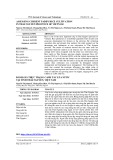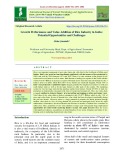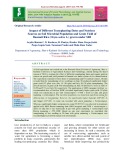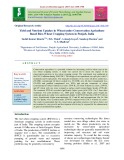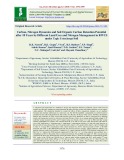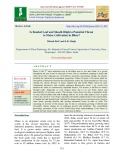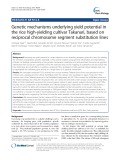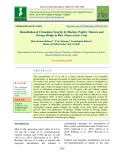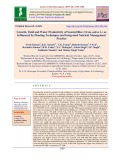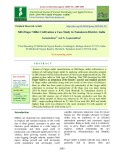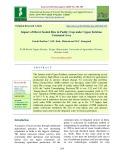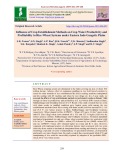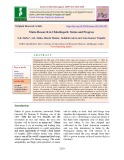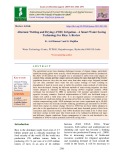
Increasing rice yield potential
-
The results of resreach showed that rice areas were not distributed relatively uniform in all districts and the rice yield had average level when compared with the other rice cultivation areas. Rice yields in Thai Nguyen province sharply increased from 4.87 tons/ha (2010) to 5.49 tons/ha (2020) with the slightly decreasing the rice areas, it is proved that the farmer was not concerned to increase the planting areas while they focused on rising the yield potential and quality.
 8p
8p  giangnhanly
giangnhanly
 02-10-2023
02-10-2023
 9
9
 2
2
 Download
Download
-
Micronutrients are not only essential for plant growth and development but are also integral to human health. Fe and Zn deficiencies cause serious nutritional problems in human beings. Increasing the micronutrient content of grain by bio-fortification offers great potential to combat micronutrient deficiency and dramatically impact human health. To find out the most suitable and profitable method of bio-fortification in aromatic rice with Zinc and Iron, a field experiment was conducted during kharif, 2019 at the Research Farm, Bihar Agricultural University, Sabour, Bhagalpur.
 8p
8p  chauchaungayxua10
chauchaungayxua10
 18-03-2021
18-03-2021
 10
10
 2
2
 Download
Download
-
Rice is staple food for more than half of the world’s population. The fast growth of the world population demands an increase of 26 % in rice production to fulfill the requirement. The rice blast caused by Magnaporthe oryzae is considered to be the most significant and potentially damaging rice disease in the world and has been responsible for 35 to 50 % global loss in rice yield causing serious constraint in global food supply.
 7p
7p  nguathienthan8
nguathienthan8
 20-10-2020
20-10-2020
 5
5
 1
1
 Download
Download
-
Rice is an important component of agri-value chain, and a life-line for the livelihood of billion rural Indians. India’s rice sector has been transformed significantly with the increase of rice production by 250% and yield by 230% between 1971 and 2015.
 16p
16p  nguaconbaynhay7
nguaconbaynhay7
 15-08-2020
15-08-2020
 10
10
 1
1
 Download
Download
-
A field experiment was carried out at the Research Farm, Division of Agronomy, Sher-eKashmir University of Agricultural Sciences and Technology, Jammu during the kharif season of 2014 to evaluate the effect of different transplanting dates and organic nutrient sources on growth and yield potential of basmati rice under system of rice intensification. The experiment consisted of three dates of transplanting and five nutrient sources.
 5p
5p  chauchaungayxua6
chauchaungayxua6
 26-06-2020
26-06-2020
 11
11
 0
0
 Download
Download
-
Conservation agriculture is a potential solution for increasing yield in wheat crop in the rice wheat cropping system. A study was carried out to assess the impact of the conservation practices in rice-wheat cropping system. The experiment was conducted at the PAU, Ludhiana during 2010-2013. The design of an experiment was split-plot with 12 treatments and 3 replications.
 11p
11p  nguaconbaynhay6
nguaconbaynhay6
 24-06-2020
24-06-2020
 9
9
 0
0
 Download
Download
-
A long-term field experiment was conducted to design and implement alternative production systems with increased resource use efficiency, productivity and to determine the effect of tillage systems and mineral fertilizers on soil organic carbon patterns. This experiment intended to evaluate the effects of these management strategies on soil structural formation and structural stabilization of a sandy loam soil. The shift from puddled - transplanted rice on the flat land to raised bed systems affects the productivity and resource use efficiency of the rice-wheat system.
 24p
24p  nguaconbaynhay6
nguaconbaynhay6
 23-06-2020
23-06-2020
 28
28
 0
0
 Download
Download
-
Maize is the 3rd most important crop in the Bihar next to rice and wheat. It is grown throughout the year in one or other part of state. Due to continuous cropping of maize and other factors like improper use of fertilizers, pesticides and climate change, the disease problem has increased in tremendous proportion. Almost all parts of the maize plant are susceptible to numerous diseases that considerably reduce the yield and quality of the crop.
 13p
13p  angicungduoc5
angicungduoc5
 14-06-2020
14-06-2020
 11
11
 0
0
 Download
Download
-
Rice is one of the most important food crops that feed over half of the global population and biggest consumer of fresh water diverted from irrigation. Water scarcity is burning issue of agriculture, outcome of climate change and unpredictable rainfall. It threatens the future of irrigated rice cultivation. Researchers developed new technology called ―Aerobic Rice‖ to cope up with present situation. Rice is grown in well-drained, non-puddled and non-saturated soils. Aerobic rice cultivar has drought tolerance capacity as well as yield potentiality.
 6p
6p  cothumenhmong5
cothumenhmong5
 17-05-2020
17-05-2020
 13
13
 1
1
 Download
Download
-
Increasing rice yield potential is a major objective in rice breeding programs, given the need for meeting the demands of population growth, especially in Asia. Genetic analysis using genomic information and high-yielding cultivars can facilitate understanding of the genetic mechanisms underlying rice yield potential.
 11p
11p  viminato2711
viminato2711
 22-05-2020
22-05-2020
 11
11
 0
0
 Download
Download
-
The accumulation of Cr in soil is a major concern because of its possible phytotoxicity or increased movement of metals into food chain and the potential for surface and ground water contamination. Excessive metal accumulation in contaminated soil can result in decrease in soil microbiological activities, soil fertility and overall soil quality which may lead to reduction in yield.
 13p
13p  caygaocaolon4
caygaocaolon4
 04-04-2020
04-04-2020
 14
14
 2
2
 Download
Download
-
Rice is sensitive to high temperature, especially at the reproductive stage, which causes spikelet sterility and yield losses. The increase in both frequency and intensity of high temperature, along with its large variability, is emerging as a potential threat to the sustainability of rice production. The predicted 2–4°C increment in temperature by the end of the 21st Century poses a threat to rice production.
 7p
7p  caygaocaolon4
caygaocaolon4
 04-04-2020
04-04-2020
 14
14
 2
2
 Download
Download
-
Rice based production systems in the sub-humid region (Purvanchal) of Uttar Pradesh are traditional, with low yield and low farm income, and they have largely missed out on the benefits of the Green Revolution. To enhance productivity, alleviate environmental and management constraints, and enhance farmers’ income in the rice–wheat cropping system of the sub-humid Purvanchal region, Uttar Pradesh, new approaches that are more productive and sustainable need to be developed.
 22p
22p  cothumenhmong3
cothumenhmong3
 22-02-2020
22-02-2020
 21
21
 2
2
 Download
Download
-
Exploiting the production potential of high yielding rice varieties through agronomic management is one of the alternatives to feed the ever growing population. For this, fertilizers from different sources and modern planting techniques have contributed substantially to the spectacular increase in rice yield and to improve soil properties. In order to study the effect of planting techniques and integrated nutrient management in rice.
 12p
12p  chauchaungayxua3
chauchaungayxua3
 07-02-2020
07-02-2020
 15
15
 0
0
 Download
Download
-
System of Finger millet intensification or SRI-finger millet cultivation is a method of cultivating finger millet by applying cultivation principles adopted in SRI (System of Rice Intensification) in order to get higher productivity. This method is also called as Guli type of Planting. This POP developed for SRIFinger Millet is an integration of the farmers’ practice and standard practices of finger millet cultivation along with two levels of two doses of fertilizers.
 6p
6p  nguaconbaynhay3
nguaconbaynhay3
 07-02-2020
07-02-2020
 29
29
 1
1
 Download
Download
-
The farmers under Upper Krishna command areas are experiencing severe water scarcity, high labour cost and unavailability of labour for agricultural production due to adverse climate change. To overcome this problem, Direct Seeded Rice (DSR) method was introduce under UKP command areas.The average crop yield of paddy under DSR method was 5.85 and 6.20 t.ha-1 andin Transplanting Practices(TP) it was 5.23 and 5.45 t.ha1 during kharif 2018 and 2019 respectively against potential yield of 7.5 t.ha-1 .
 6p
6p  nguaconbaynhay3
nguaconbaynhay3
 07-02-2020
07-02-2020
 9
9
 0
0
 Download
Download
-
Increases in rice grain yield depend on introduction of potential cultivars including hybrids into Andaman and Nicobar islands that with small acreage (5340 ha) won’t merit developing hybrids locally. The objective of this study was to evaluate newly released hybrids and high yielding varieties of rice elsewhere in the country and identify promising ones for augmenting the huge production shortages in the islands.
 8p
8p  nguaconbaynhay3
nguaconbaynhay3
 07-02-2020
07-02-2020
 9
9
 1
1
 Download
Download
-
Rice-Wheat cropping system pre-dominated in the India covering an area of about 10.5 million hectare. Adverse effect of continuous puddling in rice field forced scientists to search for other methods of rice establishment like direct seeding; machines transplanted and dry seeding with ZT machine and wheat by zero tillage etc. In a 3‐year study, we assessed the effects of crop establishment methods in participatory mode on farmers’ field through on farm on productivity and profitability in a rice–wheat (RW) system at Basti, Siddharthnagar and Gorakhpur district of U.P.
 10p
10p  nguathienthan2
nguathienthan2
 26-12-2019
26-12-2019
 21
21
 1
1
 Download
Download
-
Chhattisgarh, the 26th state of the Indian Union came into existence on November 1st, 2000. In Chhattisgarh, maize is a kharif season crop and second most important crop next to paddy in terms of both area and production. The state has got very good potential for maize but the productivity is very low due to cultivation of open pollinated varieties (OPVs) and improper input management practices. The real potential can be realized by the adoption of hybrid maize especially single cross hybrids with full package of practices.
 21p
21p  kethamoi2
kethamoi2
 14-12-2019
14-12-2019
 11
11
 1
1
 Download
Download
-
The agricultural sector faces daunting challenges because of climate change, particularly amidst increasing global water scarcity, which threatens irrigated lowland rice production. By 2025, 15-20 million ha of irrigated rice is estimated to suffer from some degree of scarcity. Rice systems provide a major source of calories for more than half of the world‟s population; however, they also use more water than other major crops. Irrigated lowland rice not only consumes more water but also causes wastage of water resulting in degradation of land.
 11p
11p  kethamoi2
kethamoi2
 14-12-2019
14-12-2019
 36
36
 0
0
 Download
Download
CHỦ ĐỀ BẠN MUỐN TÌM








